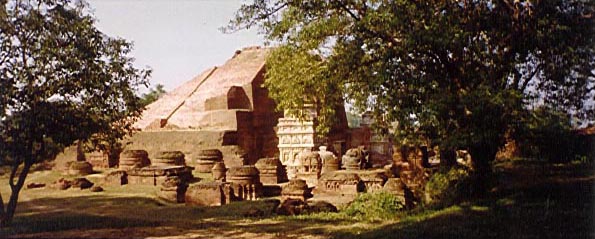Sutra is the Sanskrit term used to classify the Mahayana teachings of the Buddha. Most of these were composed in India in Sanskrit and transmitted to China, Korea, Japan, Tibet, and Mongolia where they were translated into the local languages. English translation of many of these sutras may be found on this website by clicking their title on the right or below. H.H. Dorje Chang Buddha III recommended that all Dharma Masters who have disciples should deeply enter the Heart Sutra, the Diamond Sutra, the Avatamsaka Sutra, the Lotus Sutra, the Shurangama Sutra, and the Agama Sutras (similar to the Pali Suttas). A list of some of the major sutras studied at the XFVU is provided below:
- Avatamsaka Sutra (The Flower Ornament Scripture): (Ta-fang-kuang-fo-hua-yen-ching or Fo-tuo Ga-ye ):In the mahayana tradition this is considered the First Sermon of the Buddha after His enlightenment. It was taught to Bodhisattvas and celestial beings. Contains the Gandavyuha, Dashabhumika, and Amitayurdhana Sutras.
- Expounding the Absolute Truth through the Heart Sutra (English translation of this sutra by H.H. Dorje Chang Buddha III is not yet available)
- Diamond Sutra (Essence of the Prajnaparamita Sutras)
- Heart Sutra (Essence of the Prajnaparamita Sutras): often chanted in Buddhist temples
- Lankavatara Sutra
- Mahaparinirvana Sutra: Last sutra taught by the Buddha while He lived in this world, mahayana tradition.
- Monk Sutra (English translation of this sutra by H.H. Dorje Chang Buddha III is not yet available, but it is available in Chinese in H.H. Dorje Chang Buddha, A Treasury of True Buddha-Dharma as the exoteric teaching called A Monk Expounds the Absolute Truth to a Layperson.
- Prajnaparamita Sutras (Sutra on Perfect Wisdom)
- Saddharmapundarika (Lotus) Sutra: (Miao-fa-lien-hua-ching): Primary text of the Tendai and Nicheran sects. Teaches the identification of the historical Buddha with the Transcendental Buddha. Includes the doctrine of “Expedient Means (upaya).
- Samdhinirmocana Sutra: Yoghachara text covering the meaning of the ultimate, the alaya consciousness, and the doctrine of cognition-only.
- Shurangama Sutra
- Sukhavatiyuha (Pure Land) Sutras
- Supreme and Unsurpassable Mahamudra of Liberation (English translation of this sutra by H.H. Dorje Chang Buddha III is not yet available, but the chapter on “One Hundred twenty-eight Evil and Erroneous Views” has been published and available on this website.)
- Understanding and Realizing Definitive Truth Sutra (English translation of this sutra by H.H. Dorje Chang Buddha III is not yet available, but it is available in Chinese in H.H. Dorje Chang Buddha, A Treasury of True Buddha-Dharma.
- Vimalakirti Nirdesa Sutra (The Holy Teachings of Vimalakirti): (Wei-mo-chieh-so-shuo-ching): Famous sutra in which basic mahayana principles are presented as a dialogue between an enlightened layman (ju-shi), Vimalakirti, and famous Buddhist figures. Tibetan Canon. Translations by Charles Luk and Burton Watson from Chinese Canon also available.
- Vimalakirti Sutra-Bukkyo Dendo Kyokai (BDK): translation from Chinese.
- What Is Cultivation Sutra
Other sutras that are not included on this website, but are of special importance include:
- Bhadrakalpika Sutra: The Sutra of 1000 Buddhas.Describes the various Buddhas of our present Fortunate Aeon of which Shakyamuni Buddha is the fourth and Maitreya will be the fifth.
- Karandavyuha Sutra or Ornaments of the Basket sutra.Homage to the Bodhisattva Avalokiteshvara.
- Karunapundarika Sutra or Sutra of the Lotus of Compassion: About Buddha Padmottara.
- Samadhiraja Sutra or Royal Samadhi Sutra: Teaching on emptiness.
- Samdhinirmocana Sutra or Wisdom of Buddha: Essential Questions and Direct Answers for Realizing enlightenment. Primary text of the Yogachara School.
- Sanghata Sutra or Sutra on the Pair of Monastic Assemblies (Ta ji-hui zheng-fa jing).
- Suvarnabhasottama Sutra or The Sutra of Golden Light: Provides guidance for how individuals may direct their actions toward purifying the mind, and generating peace through their practice. Sometimes called the “King of Sutras.”

